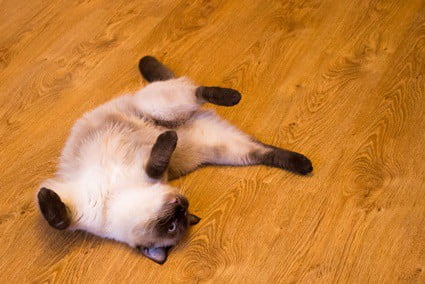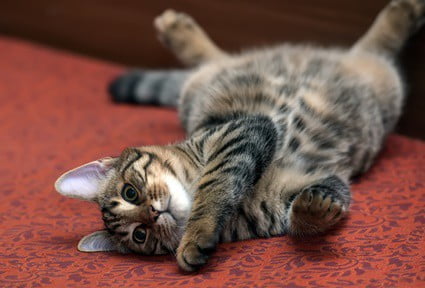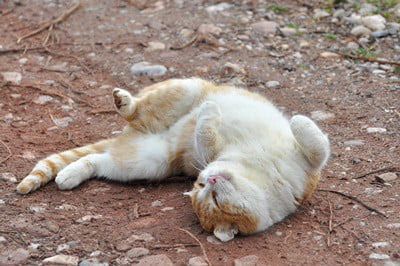You may have noticed a bump on your male cat’s stomach. In fact, upon closer inspection, you may find several lined bumps up in two neat rows. For some cats, this will be 4 bumps on each side, while others may have a random assortment. As long as they’re skin-colored and not feverish to the touch, you don’t have to worry. These are just your male cat’s nipples.
Male cats have nipples on their stomach. They do not produce milk or serve any real function. Your cat grew these in the womb before its sex hormones caused it to develop into a male. They’re a leftover of the development process. Male cats cannot produce milk, so they cannot nurse kittens, but the nipples will remain.
Kittens may still try to suckle if they’re hungry or seeking comfort, but this habit should be discouraged. If your male gets scratched or bruised in this area, the nipples may become infected. You’ll know this when they’re red, inflamed, or lack any hair around them. Overgrooming, flea and parasite infestations, and stress may cause the hair to fall out.
Is It Normal For Male Cats To Have Nipples?
It is OK for male cats to have nipples. Like all mammals, including human beings, males have these non-useful body parts as a leftover from the development process. There’s no need to be concerned unless the nipples appear infected or inflamed. They’re otherwise a natural part of your cat’s anatomy, even if they’re not functional.
Why Do Male Cats Have Nipples?
Genetically speaking, a male cat’s nipples are vestigial. That means they do not serve a real function, and there’s no biological purpose for them. Unlike female cats, males cannot lactate and feed young.
So, what’s the point of having them? The answer for this lies in how cats develop. In the womb, cats develop nipples before sex hormones are produced. For female cats, sex hormones tell the body to develop mammary glands. In turn, these glands will allow the cat to lactate when she is pregnant.
Male cats, on the other hand, produce the sex hormone testosterone. This halts the production of mammary glands. Since male cats only complete half of the process, they still form nipples, but they don’t serve a purpose.
What Do Male Cat Nipples Look Like?
Male cat nipples look similar to that of a female, at least when she’s not lactating. The nipples will be the same color as the cat’s skin. This is often a light, pale pink, and they will look like small bumps of skin on the belly.
An exception for this is found in lactating queens or female cats that are nursing kittens. Lactating cats will have bigger nipples as they are storing milk. Nipples that the kittens do not use will shrink back to their smaller size. From this point, only nipples that are commonly fed from will continue to lactate.
Since this doesn’t apply to males, their nipples will stay the same throughout their lives. Any changes in size or color may be an indication of sickness.
Where Are Male Cats Nipples?
If you think your male cat doesn’t have nipples, then don’t panic. It does, but you can’t see them. A cat’s nipples may be difficult to spot with just your eyes, especially in cats with longer fur.
Male cats have nipples on their belly. While females will lose hair around this spot as they begin to lactate, a male will not. The nipples will also not change color, as they do in a mother, so this excess of hair and skin-colored disguise may obscure the nipples from view.
If your cat allows you to pet its belly, you may be able to feel them. They will be small bumps that are equally distanced from each other. They may be a little sensitive, so don’t be surprised if your cat feels ticklish and tries to curl around your hand (watch out for scratches!).
How Many Nipples Do Male Cats Have?
Most felines have 8 nipples in 2 rows of 4. However, some cats have more or fewer nipples, depending on their genes. There is no fixed number for an average feline, so don’t worry if your cat has many more or far fewer.
Even cats that are from the same litter can have a different number of nipples. It’s normal for one cat to have 8 nipples while its sibling has 6. Although siblings can share the same genes, they aren’t identical, so differences like these are common.
A cat’s nipples are often located in even rows of 2. However, some cats have an uneven number. If your male cat has 3 on one side, 5 on the other, or any other combination, don’t worry. Your cat is perfectly healthy.
Why Do Cats Lose Hair Around Their Nipples?
There are many situations wherein a cat loses the fur around its nipples. As a whole, this is normal and doesn’t need to concern you.
Pregnant cats will naturally lose the hair around their nipples or have their hair grow considerably thinner around the area. This is to prepare the mother for the kittens that she is going to nurse. For cats that aren’t pregnant, the common reasons for this include:

Excessive Grooming
If your cat grooms its belly too often, the fur in this area may fall out. Excessive grooming is often caused by anxiety. That may result from a new change in the house, poor-quality food, or a conflict between your cat and another animal.
When excessive grooming is caused by anxiety and stress, it is called feline psychogenic alopecia. Feline psychogenic alopecia often affects the belly and the area around a cat’s nipples. The good news is, this behavior will go away on its own, provided that the cause of stress disappears.
However, if your cat is grooming to the point of injury, it is important to contact your vet. Bring your cat in for a check-up if you notice redness, irritation, and scabbing. Your vet may prescribe calming aids, like essential oils, calming sprays, and calming food or treats. The expert may also prescribe anti-anxiety medication, like alprazolam.
Allergies
Cats develop allergies much like people, and this can make the fur around their nipples fall out. The skin itself may be irritated and unable to hold the hair follicles. The cat may also feel itchy and scratch all the hair off its belly. You should look out for symptoms like:
- Sneezing
- Coughing
- Itchy and watery eyes
- Vomiting
- Diarrhea
It can be hard to narrow down what your cat is allergic to. Some cats have multiple allergies, working in tandem. If you’re having trouble, consult with a vet to discover what your cat is allergic to more systematically.
Fleas Or Parasites
Fleas and other parasites are a common reason for hair loss in cats. The parasites may weaken the cat’s immune system and steal vital nutrients, making its hair brittle and prone to falling out. If fleas are irritating the skin, your cat may scratch all its hair off.
If left untreated, this infestation can escalate into other diseases that cause hair loss. For example, according to Parasitology Research, fleas can carry the feline leukemia virus.
Even if your cat stays indoors at all times, fleas can still enter your home very easily. They can hitchhike on the bottom of your shoes, on your clothing, and even through cracks and windows. Look out for these symptoms:
- Scratching and biting
- Hair loss
- Skin problems
- Behavioral changes
When an infestation is severe, a cat can suffer from anemia, which lacks red blood cells in the blood. Symptoms of anemia include:
- Pale gums
- Rapid breathing
- Lethargy
Can Male Cats Produce Milk?
Because of how they develop in the womb, male cats cannot produce milk. They do not have mammary glands, which are responsible for both creating milk and lactating it through the nipple. As such, male cats are unable to nurse kittens, even if they try.
Male Cat Tries To Feed Kittens
If you have kittens and a male cat under the same roof, you may have noticed a peculiar sight: a male cat feeding kittens. While it may look like your cat purposefully feeding them, this is often not the case. Instead, the kittens are forcefully trying to nurse on the male cat, and the male tolerates it.
Male felines cannot produce milk, and they do not have maternal instincts. However, your male might still want to care for the young depending on:
- The personality of the male
- If it’s fixed
- How well it’s socialized
Why Do Kittens Nurse On Male Cats?
Male cats cannot provide food for kittens. The kittens should become aware of this shortly after beginning to suckle. Likewise, the pheromones that a male cat gives off are far different than the mothers. The kittens should be able to tell the difference. If they nurse anyhow, it’s likely because of:
A Need For Nutrients
If an unweaned kitten is ravenous, it will make do. Perhaps its mother is unavailable, the mother is no longer producing milk, or the kitten has been deprived of nutrients because of its pushy siblings. No matter the case, it will be desperate. Even if the male cat doesn’t produce milk or smell right to the kitten, it will still try to nurse in hopes of getting even a little more food.
In this case, you should take it as a warning sign. Check that your kitten is getting enough food, and consider bottle-feeding it if necessary.
If you’re already bottle-feeding the kitten, this could be a sign that it’s eating but not getting enough nutrients from its formula. A kitten with a full belly doesn’t necessarily mean a well-fed kitten. It will be searching for nipples of any kind, male or female, in hopes of discovering the much-needed nutrients.

A Need For Comfort
For kittens, nursing is more than just a source of food. It’s also a form of comfort and a way to soothe themselves. For this reason, weaned kittens may begin suckling on other kittens, male adults, and even other species.
Owners often report seeing their several-week-old kittens suckling on dogs, human fingers, the edges of a towel, and even their own tails. Kittens that exhibit this behavior were often:
- Weaned too early
- Abandoned by their mother
- Stressed or anxious
- Hand-raised from an early age
When removed from their primary source of comfort, kittens will seek out comfort from other sources. Once this habit has become ingrained, the cat may later suckle when it’s bored or stressed in any way.
Should Kittens Be Allowed To Nurse On A Male Cat?
Like other maladaptive behaviors, you will need to teach your kitten to stop this habit. It’s not bad for your kitten’s health, but it can escalate to more harmful behaviors in the future.
It may also encourage the male to fend off the kittens, leading to a fight or a couple of scratches. So, how do you stop this behavior?
- Every time your kitten begins to suckle, remove it from that space.
- Give it a stern “no.”
- Follow up immediately by distracting it with a treat or a toy
- Most importantly, be consistent in training
It may take a couple of weeks for your kitten to learn, but it will adapt eventually.
Can Male Cats Nipples Get Infected?
Mastitis is a common reason for infection in female cats. This refers to an infection of the mammary glands and commonly affects lactating cats. Male cats cannot get mastitis because of their lack of mammary glands. However, male cats can still have their nipples get infected.
This is usually because of a physical injury. To tell, you should look for nipples that are swollen, red, or bleeding. You may also notice bruising around the area.
While scuffles with other cats or animals are the usual culprit, it may also happen when your cat rubs against a sharp object or overgrooms. If left alone, the wound should heal on its own. If the spot becomes red and warm to the touch, you will need to consult with a vet.
Male cats do have nipples, and they serve no real purpose. However, you should still keep an eye on these body parts to ensure they don’t get irritated or injured. Cats aren’t prone to showing their bellies, so checking in now and then can ensure that an infection doesn’t get out of hand.

